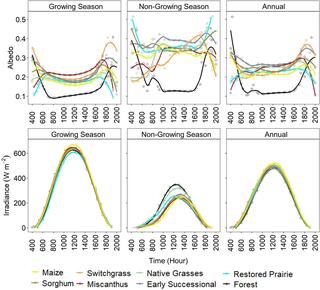Climate cooling benefits of cellulosic bioenergy crops from elevated albedo
C. Lei et al. "Climate cooling benefits of cellulosic bioenergy crops from elevated albedo" Global Change Biology - Bioenergy 15:1373 (2023) [DOI:10.1111/gcbb.13098]
Changes in land surface albedo can alter ecosystem energy balance and potentially influence climate. We examined the albedo of six bioenergy cropping systems in southwest Michigan USA: monocultures of energy sorghum (Sorghum bicolor), switchgrass (Panicum virgatum L.), and giant miscanthus (Miscanthus × giganteus), and polycultures of native grasses, early successional vegetation, and restored prairie. Direct field measurements of surface albedo (αs) from May 2018 through December 2020 at half-hourly intervals in each system quantified the magnitudes and seasonal differences in albedo (∆α) and albedo-induced radiative forcing (RF∆α). We used a nearby forest as a historical native cover type to estimate reference albedo and RF∆α change upon original land use conversion, and a continuous no-till maize (Zea mays L.) system as a contemporary reference to estimate change upon conversion from annual row crops. Annually, αs differed significantly (p < 0.05) among crops in the order: early successional (0.288 ± 0.012SE) >> miscanthus (0.271 ± 0.009) ≈ energy sorghum (0.270 ± 0.010) ≥ switchgrass (0.265 ± 0.009) ≈ restored prairie (0.264 ± 0.012) > native grasses (0.259 ± 0.010) > maize (0.247 ± 0.010). Reference forest had the lowest annual αs (0.134 ± 0.003). Albedo differences among crops during the growing season were also statistically significant, with growing season αs in perennial crops and energy sorghum on average ~20% higher (0.206 ± 0.003) than in no-till maize (0.184 ± 0.002). Average non-growing season (NGS) αs (0.370 ± 0.020) was much higher than growing season αs (0.203 ± 0.003) but these NGS differences were not significant. Overall, the original conversion of reference forest and maize landscapes to perennials provided a cooling effect on the local climate (RFαMAIZE: −3.83 ± 1.00 W m−2; RFαFOREST: −16.75 ± 3.01 W m−2). Significant differences among cropping systems suggest an additional management intervention for maximizing the positive climate benefit of bioenergy crops, with cellulosic crops on average ~9.1% more reflective than no-till maize, which itself was about twice as reflective as the reference forest.
The data presented in this work are available at the Great Lakes Bioenergy Research Center Sustainability Research Data Catalog: https://data.sustainability.glbrc.org/
